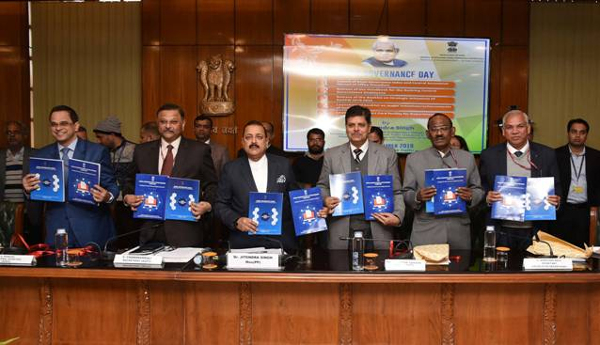New Delhi: Minister of State (MoS) (PP) Jitendra Singh launched the ‘Good Governance Index’ at an event organized by the Ministry of Personnel, Public Grievances & Pensions, on the occasion of Good Governance Day, here yesterday. Good Governance Day is observed on the birth anniversary of former Prime Minister Atal Bihari Vajpayee.
The Good Governance Index (GGI) is a uniform tool across States to assess the status of Governance and impact of various interventions taken up by the State Government and UTs. The objectives of GGI are to provide quantifiable data to compare the state of governance in all states and UTs, enable states and UTs to formulate and implement suitable strategies for improving governance, and shift to result oriented approaches and administration.
Various principles have been kept in mind while selecting the indicators, i.e. it should be easy to understand & calculate, citizen-centric & result driven, leading to improved results and applicable to all states and UTs, among others. Various consultation meetings were held with the stakeholders, including consultations with sector experts, ministries, states & UTs.
The GGI takes into consideration ten sectors:
- Agriculture and Allied Sectors,
- Commerce & Industries,
- Human Resource Development,
- Public Health,
- Public Infrastructure & Utilities,
- Economic Governance,
- Social Welfare & Development,
- Judicial & Public Security,
- Environment
- Citizen-Centric Governance.
These ten Governance sectors are measured on 50 indicators. Different indicators are given different weightage under one Governance Sector to calculate the value.
For example, under Agriculture & Allied Sector there are 6 indicators with different weightage, namely: Growth rate of agriculture and allied sector (0.4), growth rate of food grains production (0.1), growth rate of horticulture produce (0.1), growth rate of milk production (0.1), growth rate of meat production (0.1) and crop insurance (0.2).
The states and UTs are divided into three groups – Big States; North-East & Hill States; and UTs. States and UTs are ranked on all indicators separately, and at the same time composite ranking is also calculated for these states and UTs under their respective groups based upon these indicators.
Source: ID
Image Courtesy:PiB
You may also like
-
Trade Connect E-platform For Exports Is Single Window, Fast, Accessible And Transformational: Shri Piyush Goyal
-
Dot Simplifies Approval Processes For Telecom Licenses And Wireless Equipment
-
Coal Production and Supply Trends on Positive Trajectory
-
Union Minister To Release Booklets On Promotion Of Indigenous Species & Conservation Of States Fishes
-
2nd India-Japan Finance Dialogue held in Tokyo on 6th September, 2024
